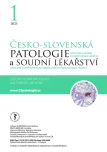Standard autopsy and diagnostic procedure in forensic departments in cases of sudden cardiac death (SCD) in individuals under 40 years of age
Authors:
Martin Zeman 1; Štěpánka Pohlová Kučerová 2; Tomáš Vojtíšek 1; Petr Hejna 2
Authors‘ workplace:
Ústav soudního lékařství LF MU a FNUSA Brno, Brno
1; Ústav soudního lékařství LF UK a FN Hradec Králové, Hradec Králové
2
Published in:
Soud Lék., 68, 2023, No. 1, p. 2-10
Category:
Review
Overview
Sudden cardiac death (SCD) in individuals younger than 40 years has a heritable cause in a significant part of the cases. Identification of SCD, post mortem genetic analysis, and the cardiological screening examination in victim´s relatives represent an important diagnostic tool for the primary prevention of cardiac arrest. Based on global and European recommendations, cases of sudden cardiac death in individuals under the age of 40 with negative or ambiguous autopsy findings, or findings suspicious for hereditary cardiovascular disease, should be investigated using molecular genetic methods. Based on European guidelines, the Czech Society of Forensic Medicine and Forensic Toxicology has developed its own recommended procedure, which summarizes the identification of these cases, the optimal autopsy procedure, including the collection of material, and a summary of other necessary actions for performing a post mortem genetic examination in a person who has died suddenly. Complex examination of these cases requires multicentric and multidisciplinary collaboration.
Keywords:
prevention – guidelines – sudden cardiac death – inherited cardiovascular diseases – post mortem genetic analysis
Sources
1. Basso C, Aguilera B, Banner J, et al. Guidelines for autopsy investigation of sudden cardiac death: 2017 update from the Association for European Cardiovascular Pathology. Virchows Arch 2017; 471(6): 691-705.
2. Virmani R, Burke AP, Farb A. Sudden cardiac death. Cardiovasc Pathol 2001; 10(6): 275-282.
3. Brinkmann B. Harmonisation of medico-legal autopsy rules. Int J Legal Med 1999; 113(1): 1-14.
4. Priori SG, Blomström-Lundqvist C, Mazzanti A, et al. 2015 ESC Guidelines for the management of patients with ventricular arrhythmias and the prevention of sudden cardiac death: The Task Force for the Management of Patients with Ventricular Arrhythmias and the Prevention of Sudden Cardiac Death of the European Society of Cardiology (ESC) Endorsed by: Association for European Paediatric and Congenital Cardiology (AEPC). Europace 2015; 17(11): 1601-1687.
5. Fellmann F, van El CG, Charron P, et al. European recommendations integrating genetic testing into multidisciplinary management of sudden cardiac death. Eur J Hum Genet 2019; 27(12): 1763-1773.
6. Myerburg RJ, Kessler KM, Castellanos A. Sudden cardiac death: Structure, function, and time-dependence of risk. Circulation 1992; 85(1 Suppl): I2-10.
7. Raju H, Parsons S, Thompson TN, et al. Insights into sudden cardiac death: exploring the potential relevance of non-diagnostic autopsy findings. Eur Heart J 2019; 40(10): 831-838.
8. Stiles MK, Wilde AAM, Abrams DJ, et al. 2020 APHRS/HRS expert consensus statement on the investigation of decedents with sudden unexplained death and patients with sudden cardiac arrest, and of their families. Heart Rhythm 2021; 18(1): e1-e50.
9. Stiles MK, Wilde AAM, Abrams DJ, et al. 2020 APHRS/HRS expert consensus statement on the investigation of decedents with sudden unexplained death and patients with sudden cardiac arrest, and of their families. J Arrhythm 2021; 37(3): 481-534.
10. Zeman M, Sepši M, Vojtíšek T, Šindler M. Suddenly deceased young individuals autopsied at the Department of forensic medicine, Brno – analysis. Soud Lek 2012; 57(3): 44-47.
11. Pohlová Kučerová Š, Krebsová A, Votýpka P, et al. Outcomes of a multicenter study of the causes of sudden cardiac death (SCD) in the Czech Republic and primary prevention of cardiac arrest in relatives. Výstupy multicentrické studie příčin náhlé srdeční smrti (SCD) v České republice a primární prevence srdeční zástavy u příbuzných. Soud Lek. 2022; 67(2): 10-24.
Labels
Anatomical pathology Forensic medical examiner ToxicologyArticle was published in
Forensic Medicine

2023 Issue 1
Most read in this issue
